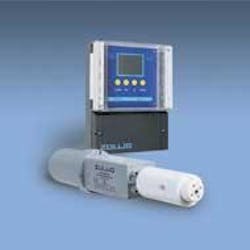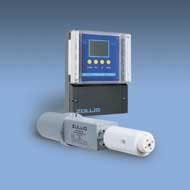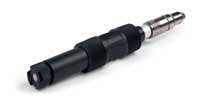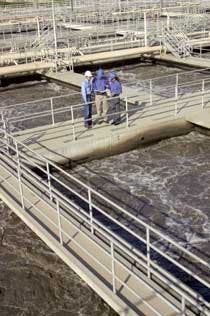DO Monitoring Plays Key Role in Aeration Basin Performance
By John Volbeda
Today's plant operators and managers are juggling stringent environmental compliance issues, tighter budgets, fewer personnel and increased security concerns, all while striving to increase plant capacity. For wastewater treatment plants to keep all these balls in the air means that systems must be operating at peak efficiency at all times.
However, for all of the employees eager to meet the demands of the market with hard work and technological advancements, Mother Nature still plays a critical role in the breakdown of organic wastes entering a wastewater treatment facility.
In fact, the microscopic organisms and bacteria that break down active sludge in aeration basins are responsible for most of the work. Maintaining an environment conducive to keeping these bacteria alive and most productive is a critical job for plant managers and operators.
If the dissolved oxygen content is too low, the environment is not stable for these organisms and they will die, the sludge will not be properly treated and plants will be forced to conduct an expensive and time-consuming biomass replacement process. Because of this risk, many plants compensate by adding excessive amounts of dissolved oxygen to their process. However, when the dissolved oxygen levels become too high, energy is wasted and expensive aeration equipment undergoes unnecessary usage.
The crucial question many plants face is how to maintain the proper dissolved oxygen levels to keep the bugs alive without killing the operations budget. And the answer is purely a question of monitoring choices.
Process and Power
Dissolved oxygen is added to the aeration basin to enhance the oxidation process by providing oxygen to aerobic bacteria so they can successfully turn organic wastes into inorganic byproducts, specifically carbon dioxide, water and sludge, which may contain nitrated phosphates, sulfates and highly active bacteria. Stated simply, there are two main categories of bugs that digest waste – carbon eaters (carbonaceous) and ammonia eaters (nitrogenous) – and both of these groups need oxygen to reproduce and sustain life.
This oxidation process, commonly known as the activated sludge process, is the most widely used method of secondary waste treatment today.
In order to keep the treatment process functioning properly, the measurement of dissolved oxygen is a critical step. However, many wastewater plants today still use inefficient batch monitoring techniques to measure DO in aeration basins as a means of gauging the need for oxygen and ensuring that adequate levels of oxygen are present. Because batch measurement is less efficient and accurate than continuous monitoring, plants often compensate with the over-use of aeration equipment to bubble in more air or oxygen than may be required.
Power costs associated with the operation of the aeration process generally run from 30 to 60 percent of the total electrical power used by a typical wastewater treatment facility. Today, however, plant managers can equip their aeration basins with on-line analysis systems that provide continuous dissolved oxygen measurement. Couple this analysis with automatic aeration systems, and according to the EPA, plant energy costs may be reduced by as much as 50 percent.
In addition, continuous measurement can also help plant personnel better respond to rapid increases or decreases in plant loads, enabling the plant to operate more efficiently overall.
The first step for plants to undertake is to conduct a feasibility study to help determine the amount of energy savings that could be achieved using the proper technology for dissolved oxygen measurement. Once the benefit of continuous monitoring is determined, plant managers must next select the type of sensor best suited to their application.
Instrumentation
Wastewater treatment plants represent one of the toughest and most challenging environments for measurement sensors. Sensors can become coated, dirty and ineffective in aeration basins. There are two kinds of on-line dissolved oxygen sensors that can withstand this application – membrane sensors and bare- or open-electrode sensors – and both offer pros and cons.
Membrane Sensors
Membrane sensors operate by isolating the electrodes and electrolyte from the sample by means of a semipermeable membrane. This membrane acts to protect the electrode from contamination by restricting the flow to gases only, and in particular, oxygen. In the most widely used technique for membrane measurement, an externally applied polarizing voltage drives the electrodes. The current flow between the electrodes can be directly correlated to the amount of oxygen present in the process.
The membrane sensor is often a good choice for wastewater treatment plants. It is a cost-effective purchase, is easy to calibrate and is easy to service since it incorporates no moving parts. In addition, membrane dissolved oxygen sensors are lightweight and resistant to heavy metal electrode poisoning.
One of the drawbacks to membrane sensors is that the membrane can get coated and require regular cleaning, usually at weekly intervals. Today, however, these maintenance requirements can be overcome using an air blast sensor cleaning system that blows a jet stream of air for a short period (usually one to three minutes) at set intervals, such as every eight hours. The programmable timer in the analyzer can control the cleaning frequency, and a small high-efficiency compressor, conveniently located near the sensor, provides the air supply. This kind of air blast system cleans the sensor and eliminates the need to remove it from the process for cleaning. As a result, membrane sensors used in combination with air blast cleaning systems, can last three months or longer before any sensor cleaning maintenance is required.
Open- or Bare-electrode Sensors
In the open- or bare-electrode design, the electrodes are two independently spring-loaded concentric rings, insulated from each other. These electrodes are subject to the same fouling agents that afflict membrane-type sensors, but a rotating diamond grindstone continuously polishes the electrode surfaces. This self-cleaning capability eliminates the time-consuming tasks of cleaning and replacing membranes and replenishing the electrolyte solution required in traditional membrane sensors.
The open electrodes are protected from exposure to air bubbles and suspended solids in the process solution by a sample chamber, in which fresh sample is pumped to the electrodes through an oscillating chamber. This chamber also ensures that sufficient sampling occurs in wastewater with low-flow or zero-flow rates.
The primary benefits that open- or bare-electrode sensors provide are long life, lower long-term total cost of ownership and reduced maintenance requirements.
Because of the self-cleaning design, the probe housing can last 15 to 20 years, as opposed to membrane sensors that typically last three to five years. Practically the only maintenance requirement for open-electrode sensors is to replace the rotating diamond grindstone every eight to 18 months, and replace the electrodes every three to five years. While the open-electrode sensors have a higher initial investment cost than membrane sensors, the reduced maintenance costs and long life can translate to a lower total cost of ownership over the life of the sensor. In addition, bare-electrode dissolved oxygen probes are typically built mechanically rugged and can withstand certain environments better than membrane sensors, especially greasy or oily applications.
Conclusion
Maintaining the proper level of dissolved oxygen can only be accomplished accurately and continuously with an on-line dissolved oxygen instrument in combination with controlling the aeration rate by adjusting the blower output. In addition, many of today's more sophisticated dissolved oxygen measurement systems can provide local and remote alarms to alert plant personnel to problems. These functionalities allow plant managers to assign dissolved oxygen monitoring to less-skilled staff in a continuous monitoring environment than has traditionally been required for batch sampling.
The selection of a membrane or open-electrode dissolved oxygen sensor is based on each plant's specific needs. However, both sensor designs are ideally suited to building a continuous dissolved oxygen monitoring system to ensure accurate, up-to-date readings, and proper aeration for efficient wastewater treatment.
About the Author: With over 20 years of industrial process and control experience, John Volbeda serves as industry manager for the water and wastewater and power industries for the Liquid Division of Emerson Process Management, Rosemount Analytical. Rosemount Analytical can be reached at www.raihome.com, 800-854-8257 or at 2400 Barranca Parkway, Irvine, CA 92606.


